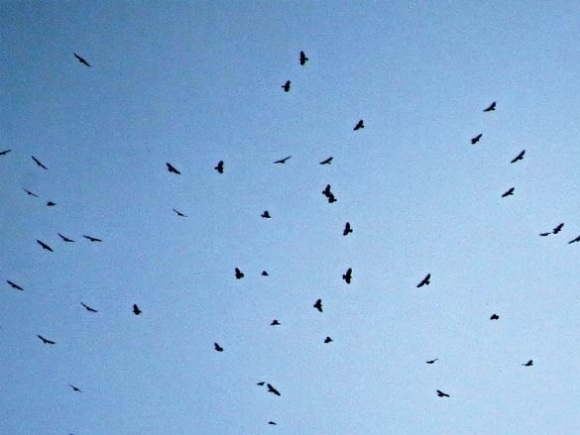A wall can’t stop these migrants

Regrettably a wall through desert and riparian lowlands along the Mexico-U.S. border will have terrible effects on terrestrial fauna whose home range includes both sides of an imaginary line in the sand. However other migrants will, likely, never notice a wall unless, of course, it is lit up like an airport landing strip.
The fall migration of neotropical migrants back to their wintering grounds in Central and South America is in full swing. The skies are full of migrating birds. Raptors — like hawks and eagles — migrate during the day when the sun’s heat creates thermals (updrafts of warm air) so they can glide towards their destinations in Central and South America. Songbirds, like warblers and thrushes, etc., migrate at night. No one knows exactly why but prevailing theory is, they are safer from predators at night and they use celestial objects like the moon and bright stars to find their way.
An admission here — I’m a birder and fall migration excites me a bit. There is no other time in the region when one can see thousands of broad-winged hawks circling in a kettle and drifting south or southwesterly, or catch shorebirds looking for a break at places like Hooper Lane and/or Rankin Bottoms. I have managed, over the past couple of weeks to slip away for a day or two, to see what’s in the air, and I haven’t been disappointed.
I made it up to Ridge Junction Overlook on the Blue Ridge Parkway on Sept. 17. The gap here at Ridge Junction (adjacent the entrance to Mt. Mitchell) must create a vortex — migrants just stream through. I saw, in the span of two or three hours, a hundred or so Swainson’s thrushes, nearly that many rose-breasted grosbeaks, 40 to 50 Cape May warblers and dozens of more birds, both resident and migrant including red-crossbill, red-breasted nuthatch, blue-gray gnatcatcher, yellow-throated vireo, blue-headed vireo, Tennessee warbler, black-throated green warbler and many others including more than 30 ruby-throated hummingbirds.
A few days later I snuck back up to the parkway, this time much closer to home around mile-marker 437, to a place I’ve long suspected would be a good spot to find migrating broad-winged hawks. Over the years I have seen the occasional kettle of broad-wings but I got really fortunate the other day. My hawk watching time was limited due to my kid-taxi duties and I was beginning to think the trip was going to be a bust when I saw a lonely broad-wing rise out of the valley. It drifted across the parkway and streamed off to the southwest.
There was nothing for about 10 minutes, then another solo broad-wing drifted up and over the parkway, then nothing, again. It was getting close to time to leave when I noticed a dark bullet powering it’s way towards me. I got my binoculars on it and could see it was a small dark barrel-chested falcon – a Merlin! I watched as it sipped across the road and when I turned back it was as if someone had opened the floodgates. There were dozens of broad-wings circling lazily up from the valley – kettling. And the kettle continued to grow till there were more than a hundred birds in it. Another large kettle followed right behind with some smaller groups streaming overhead. Within 20 minutes I counted around 450 migrating broad-winged hawks and I had to leave to shuffle kids around, so I don’t know what may have followed.
(Don Hendershot is a naturalist and a writer who lives in Haywood County. He can be reached at This email address is being protected from spambots. You need JavaScript enabled to view it.)





